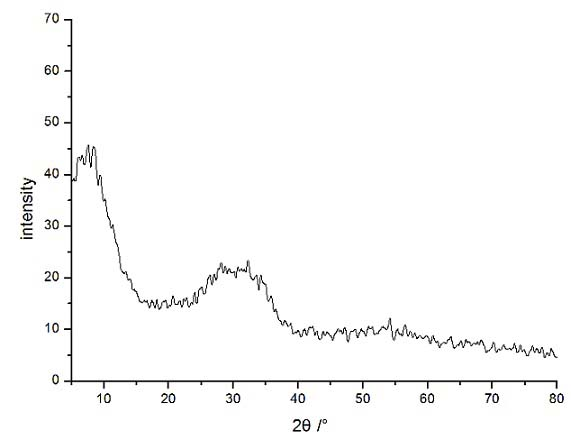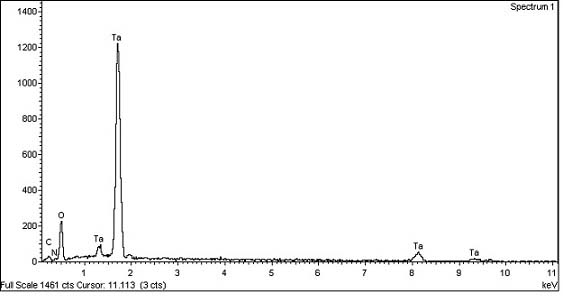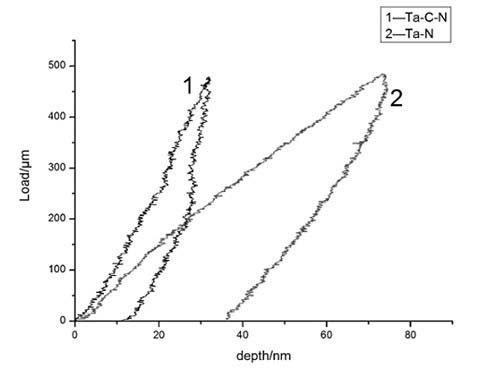Preparation method of Ta-C-N thin-film
A ta-c-n, thin film technology, applied in the direction of ion implantation plating, metal material coating process, coating, etc., can solve the problems of reducing the proportion of bonds, increasing the partial pressure of nitrogen, and reducing the deposition rate, etc., to reach the surface Smooth and dense, high nano-hardness, high sputtering deposition rate
- Summary
- Abstract
- Description
- Claims
- Application Information
AI Technical Summary
Problems solved by technology
Method used
Image
Examples
example 1
[0030] (1) Treatment of magnetron sputtering targets
[0031] Grind the surface of the commercially available Ta target and graphite target with sandpaper to remove possible impurities and oxides on the surface, wipe with alcohol and then dry;
[0032] (2) Surface activation treatment of single crystal Si substrate
[0033] Immerse the Si substrate in ethanol and ultrasonically clean it for 15 minutes; then soak it in a solution of hydrogen peroxide: concentrated sulfuric acid = 1:2 for 15 minutes; take it out and put it in a solution containing HF: deionized water = 1:10 for 30 seconds; The slices were blown dry with nitrogen;
[0034] (3) Magnetron sputtering process
[0035] Put the Ta target, graphite target and Si substrate into the main sputtering chamber and the sampling chamber respectively, and evacuate the main sputtering chamber and the sampling chamber to 1×10 -5 Pa;
[0036] The Ta target and the graphite target were pre-sputtered for 20 min to clean the impur...
example 2
[0038] (1) Treatment of magnetron sputtering targets
[0039] Grind the surface of the commercially available Ta target and graphite target with sandpaper to remove possible impurities and oxides on the surface, wipe with alcohol and then dry;
[0040] (2) Surface activation treatment of single crystal Si substrate
[0041] Immerse the Si substrate in ethanol and ultrasonically clean it for 15 minutes; then soak it in a solution of hydrogen peroxide: concentrated sulfuric acid = 1:2 for 15 minutes; take it out and put it in a solution containing HF: deionized water = 1:10 for 30 seconds; The slices were blown dry with nitrogen;
[0042] (3) Magnetron sputtering process
[0043] Put the tantalum target, graphite target and Si substrate into the main sputtering chamber and the sampling chamber respectively, and evacuate the main sputtering chamber and the sampling chamber to 1×10 -5 Pa;
[0044] The Ta target and the graphite target were pre-sputtered for 20 min to clean the...
example 3
[0046] (1) Treatment of magnetron sputtering targets
[0047] Grind the surface of the commercially available Ta target and graphite target with sandpaper to remove possible impurities and oxides on the surface, wipe with alcohol and then dry;
[0048] (2) Surface activation treatment of single crystal Si substrate
[0049] Immerse the Si substrate in ethanol and ultrasonically clean it for 15 minutes; then soak it in a solution of hydrogen peroxide: concentrated sulfuric acid = 1:2 for 15 minutes; take it out and put it in a solution containing HF: deionized water = 1:10 for 30 seconds; The slices were blown dry with nitrogen;
[0050] (3) Magnetron sputtering process
[0051] Put the tantalum target, graphite target and Si substrate into the main sputtering chamber and the sampling chamber respectively, and evacuate the main sputtering chamber and the sampling chamber to 1×10 -5 Pa;
[0052] Pre-sputter the tantalum target and the graphite target for 20 minutes to clean ...
PUM
 Login to View More
Login to View More Abstract
Description
Claims
Application Information
 Login to View More
Login to View More - R&D
- Intellectual Property
- Life Sciences
- Materials
- Tech Scout
- Unparalleled Data Quality
- Higher Quality Content
- 60% Fewer Hallucinations
Browse by: Latest US Patents, China's latest patents, Technical Efficacy Thesaurus, Application Domain, Technology Topic, Popular Technical Reports.
© 2025 PatSnap. All rights reserved.Legal|Privacy policy|Modern Slavery Act Transparency Statement|Sitemap|About US| Contact US: help@patsnap.com



